How to Say Family in Chinese | With Writing and Symbols
Learning how to say family in Chinese is crucial for anyone learning Mandarin Chinese. Whether you are a language enthusiast or just curious about Chinese culture, learning family-related vocabulary and Chinese letters will open the door to understanding one of the most important aspects of Chinese society.
In this article, we will introduce you to how to say family in Mandarin Chinese, family members in Chinese language, the symbol for family in Chinese, and more. From understanding the vocabulary of basic family members to exploring Chinese family culture. Let’s get started!
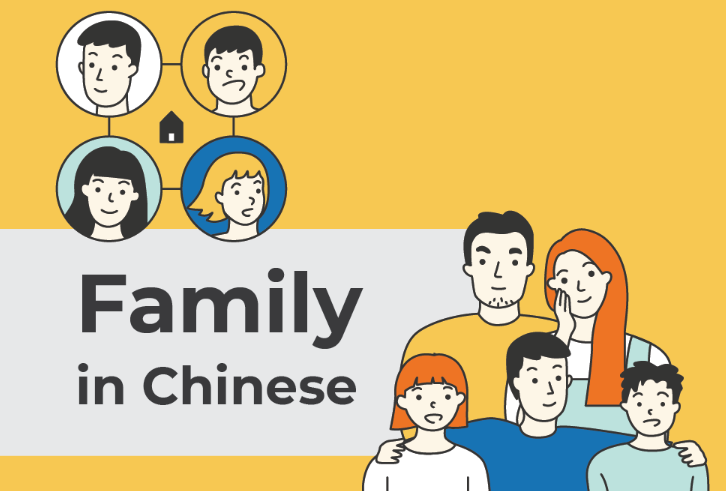
How to Say Family in Chinese Language?
One of the first and most meaningful words to learn when learning Chinese is “family”. So, how do you say “family” in Chinese?
The Chinese word “家 jiā” is also often called “家庭”, and is pronounced “jiā tíng” in pinyin. It is composed of two characters: 家 (jiā), which means “home”, “house” or “family”; 庭 (tíng), which can mean “courtyard” or “hall”. These two Chinese characters together represent the physical home, the family members, and relationships.
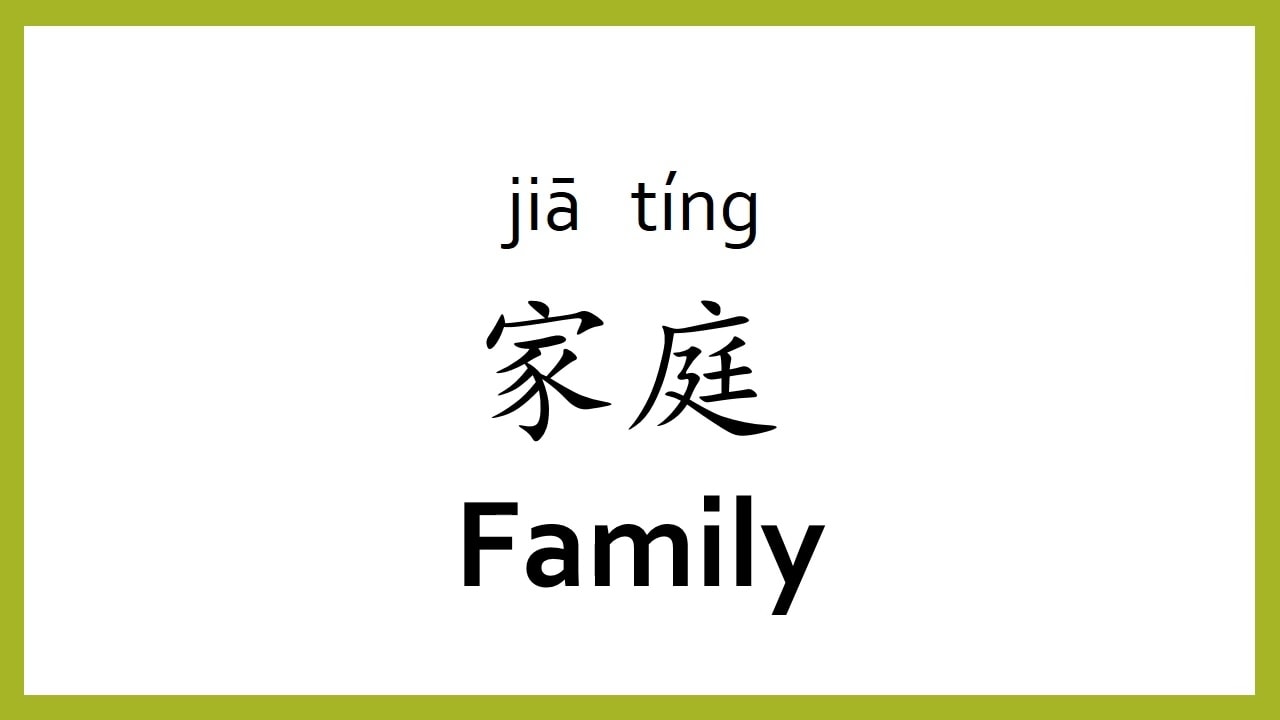
Pronunciation guide for ‘family’ in Mandarin Chinese
To pronounce 家(jiā) and 家庭 (jiā tíng) correctly, you should focus on the tones:
- 家 Jiā is the first tone, high and flat.
- 庭 tíng is the second tone, raised in pitch, as in a question.
Mandarin Chinese language tones are crucial to accurate pronunciation, so practicing these tones carefully will make your pronunciation more natural.
The word 家庭 is widely used in both spoken and written Chinese. For example, if you want to talk about your family, you can say:
- 我的家庭很幸福。 (Wǒ de jiā tíng hěn xìng fú.) – “My family is very happy.”
If you’re just starting, it’s helpful to recognize that 家 (jiā) is a polysemous Chinese character. By itself, it usually means ‘home’ or ‘house,’ but when it is combined with other words, it forms words related to family members and family relationships. For example:
- 家人 (jiā rén) – “Family members”
- 家庭观念 (jiā tíng guān niàn) – “Family values”
Learning how to say family in Chinese is not just about words, but also about understanding an important concept in Chinese culture. The family is seen as the foundation of Chinese society and this is reflected in the Chinese language.
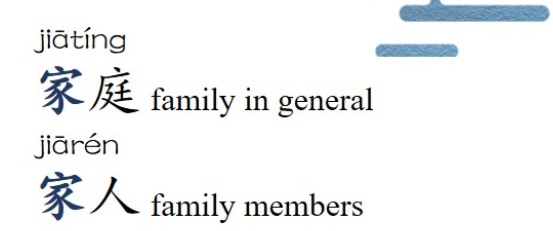
How to Address Family Members in Chinese?
The Chinese family structure is complex, and there are specific names for different relatives based on age, gender, and blood relationship. Below, we have listed common family members in Chinese, including pinyin and English meanings.
Immediate Family Members Terms in Chinese
Let’s start with the basics: your immediate family members. These people are who you would usually call your family, or 家人 (jiārén).
| Chinese | Pinyin | English |
| 父母 | fùmǔ | parents |
| 父亲 | fùqīn | father |
| 爸爸 | bàba | dad |
| 母亲 | mǔqīn | mother |
| 妈妈 | māma | mom |
| 兄弟姐妹 | xiōngdìjiěmèi | siblings |
| 哥哥 | gēge | older brother |
| 弟弟 | dìdi | younger brother |
| 姐姐 | jiějie | older sister |
| 妹妹 | mèimei | younger sister |
If you have any questions about these terms, check out the following explanation of how to refer to immediate family members in Chinese.
- 爸爸 (bàba): An informal and widely used term for ‘dad’ in Chinese
- 妈妈 (māma): Commonly used term for ‘mum’ in Mandarin.
- 哥哥 (gēge): used to address an older male sibling.
- 弟弟 (dìdi): used to refer to the younger male sibling.
- 姐姐 (jiějie): used for an older female sibling.
- 妹妹(mèimei): for younger female siblings.
Extended Family Members or Relatives in Chinese
Beyond your immediate family, you also have relatives, or 亲戚 (qīnqì). This is where things get tricky! Let’s start by going up a level on the family tree and looking at how to address grandparents.
Grandparents in Chinese:
In Chinese family culture, different terms are used depending on whether the grandparents are paternal or maternal:
| Chinese | Pinyin | English | Family Relatives |
|---|---|---|---|
| 祖父 | zǔfù | Paternal grandfather | Formal term for a grandfather from the paternal side. |
| 爷爷 | yéye | Paternal grandpa | More commonly used in daily conversation. |
| 祖母 | zǔmǔ | Paternal grandmother | Formal way to say grandmother from the paternal side. |
| 奶奶 | nǎinai | Paternal grandma | A more colloquial Chinese term. |
| 外公 | wàigōng | Maternal grandpa | Refers to a grandfather from the maternal side. |
| 外婆 | wàipó | Maternal grandma | Used for a grandmother on the maternal side. |
Extended Family Members in Chinese:
Since families in Chinese culture are traditionally large and multi-generational, it is also important to know how to address other relatives:
| Chinese | Pinyin | English | Family Relatives |
|---|---|---|---|
| 叔叔 | shūshu | uncle | father’s younger brother |
| 伯伯 | bóbo | uncle | father’s older brother |
| 舅舅 | jiùjiu | uncle | mother’s brother |
| 姑姑 | gūgu | aunt | father’s sister |
| 阿姨 | āyí | aunt | mother’s sister |
| 堂兄 | tángxiōng | older male cousin | father’s side |
| 堂弟 | tángdì | younger male cousin | father’s side |
| 表哥 | biǎogē | older male cousin | mother’s side |
| 表妹 | biǎomèi | younger female cousin | mother’s side |
Family Tree in Chinese
If you want to know more about Chinese family members and other information, below is a family tree in Chinese through which you can learn more about how family members are expressed in Chinese:

Writing and Recognizing Family in Chinese Characters
Chinese characters are rich in culture and history, and understanding their composition can deepen your understanding of the language. Let’s break down the two Chinese characters that make up the word ‘家庭’ and learn how to write them step by step.
Family in Chinese Writing
How to write 家 jiā:
- 宀(roof): Write the horizontal stroke first, then the downstrokes on both sides.
- 豕 (pig): Write the horizontal stroke first, then complete the vertical stroke and the curved part below.
There are 10 strokes in total, so you can practice several times to master the structure of the Chinese character.
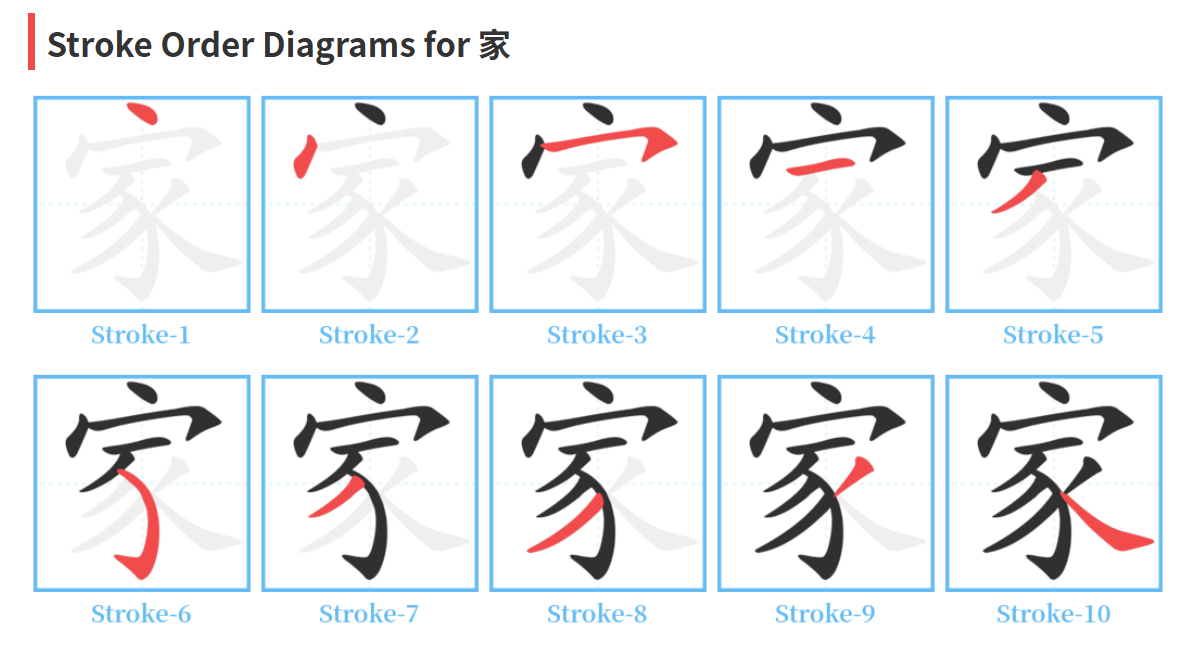
How to Write 庭 tíng:
The word 庭 (tíng) refers to a courtyard or hall, symbolising an extension of the home and a meeting place for family members. It is composed of the following parts:
- 广 (guǎng) – the radical meaning ‘residence’ or ‘building’; Start with a horizontal and diagonal stroke from the top, followed by a vertical line and a hook.
- 廷 (tíng): This radical indicates an open space or hall, usually associated with formal gatherings or family interactions; Start with the horizontal and vertical strokes, then complete the curved and slanted sections.
There are 9 strokes in total, and you should pay attention to the balance between the two parts.
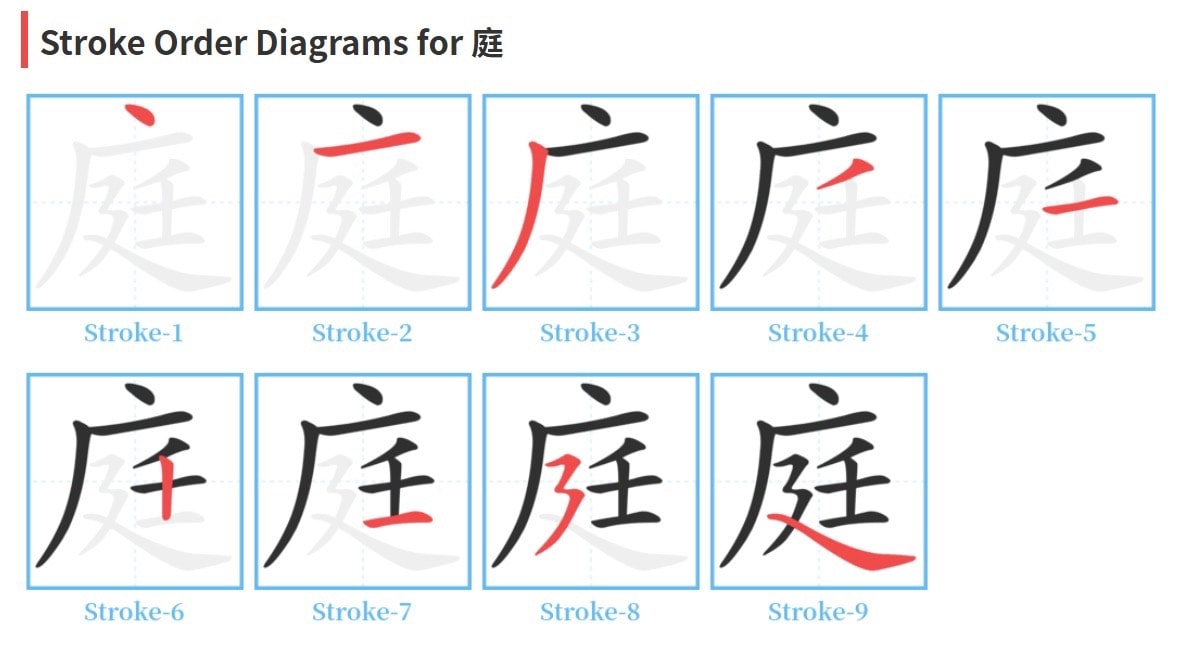
The Symbol for Family in Chinese
In traditional Chinese culture, the concept of the family is far-reaching, with a number of symbols vividly representing the essence of the family and embodying the values, traditions, and emotions that are deeply rooted in the hearts of the Chinese people.
Meaning of the Chinese Symbol for Family “家” (jiā)
The primary meaning of 家 jiā is a dwelling or living place. The character “家” (jiā) is a compound ideogram and also a phonetic loan character. The character for ‘家’ is the most direct and basic symbol of the family.
It consists of the radical ‘宀’ which represents a shelter or a house, and the character ‘豕’, which originally means pig, which vividly depicts the image of the family.
In ancient China, raising pigs was a common practice among Chinese families, symbolizing prosperity and stability. A family with a roof over its head, shelter from the wind and rain, and livestock to feed it was considered to be a complete and harmonious whole.
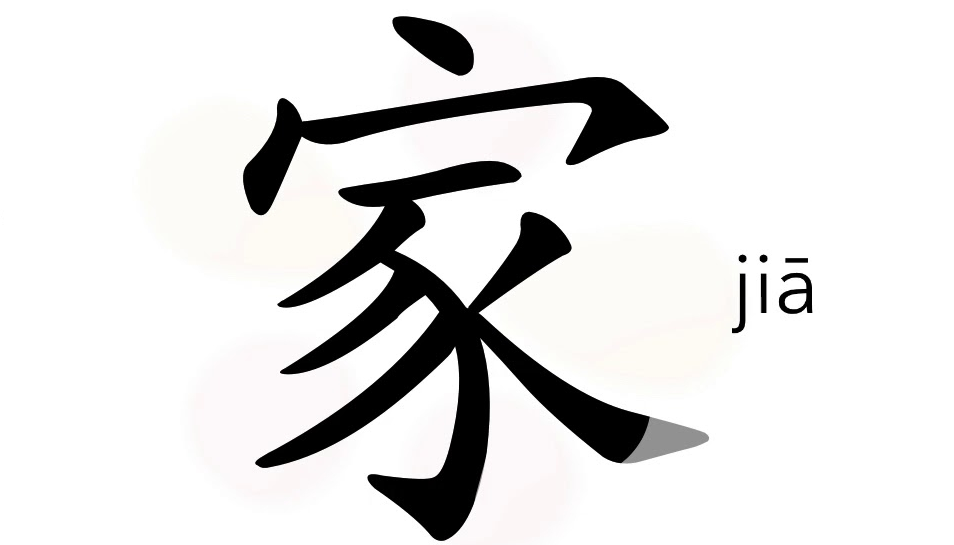
The Importance of Family in Chinese Culture
In Chinese culture, the family unit is more than just a social unit; it is the foundation of society and the core value that shapes traditions, relationships, and even the Chinese language.
Understanding the importance of the family in Chinese culture will help you understand why words related to the family have such deep meaning.
Family Values in Chinese Culture
Family values are strong in Chinese society. The Chinese family unit is guided by the Confucian principle of filial piety, which emphasizes respect for elders and ancestors.
This value shapes family dynamics in which roles and responsibilities are clearly defined: parents are seen as providers and authority figures, while children are expected to show loyalty and respect to their elders. Extended family members such as grandparents and cousins also play an important role in daily life, and they often live together or stay in close contact.
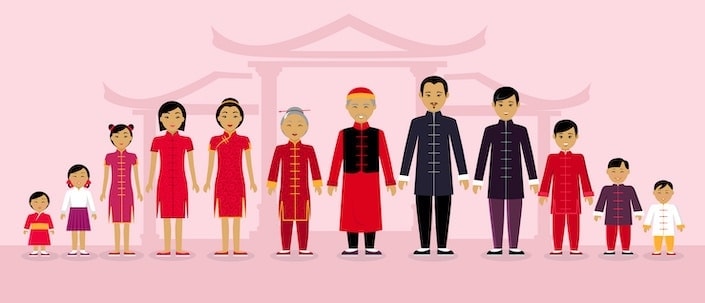
FAQs on Family in Chinese
1. What are some cultural phrases or idioms about family in Chinese?
There are many idioms and phrases in Chinese that reflect the importance of family. Here are a few examples:
- 家和万事兴 (jiā hé wàn shì xīng) – The family and all things are flourishing.
- 天伦之乐 (tiān lún zhī lè) – The happiness of family life.
- 父慈子孝(fù cí zǐ xiào)- Father’s kindness and son’s filial piety.
These phrases express the values of unity, respect and happiness in the family.
2. What is the difference between 家 jiā and 家庭 jiā tíng?
Although both ‘家’ (jiā) and ‘家庭’ (jiā tíng) are related to family, they are used in slightly different ways:
- 家 jiā: means ‘home’ or ‘house’, but can also mean ‘family’. For example, “我回家了” (Wǒ huí jiā le) – “I’m home”.
- 家庭: Specifically refers to the family unit or household. It is more formal and is used in the following contexts: 我的家庭非常温馨和睦(Wǒ de jiā tíng fēi cháng wēn xīn hé mù)- My family is very warm and harmonious.
Conclusion
Learning about the concept of family in Chinese can open a window into Chinese society. In addition, understanding family values in Chinese culture and recognizing Chinese characters related to family in Chinese can develop language skills and cultural appreciation.
If you want to learn more about the Chinese language and culture, you can comment below. Let’s all start practicing Chinese now and explore more of the Chinese language world!
Learn authentic Chinese from those who live and breathe the culture.
Specially tailored for kids aged 3-18 around the world!
Get started free!Master’s degree from Yangzhou University. Possessing 10 years of experience in K-12 Chinese language teaching and research, with over 10 published papers in teh field of language and literature. Currently responsible for teh research and production of “WuKong Chinese” major courses, particularly focusing on teh course’s interest, expansiveness, and its impact on students’ thinking development. She also dedicated to helping children acquire a stronger foundation in Chinese language learning, including Chinese characters, phonetics (pinyin), vocabulary, idioms, classic stories, and Chinese culture. Our Chinese language courses for academic advancement aim to provide children with a wealth of noledge and a deeper understanding of Chinese language skills.




![Math League: Competitions, Challenges, and Achievements [2025 Full Guide] Math League: Competitions, Challenges, and Achievements [2025 Full Guide]](https://wp-more.wukongedu.net/blog/wp-content/uploads/2024/01/school-2353406-520x293.jpg)




![30 Celsius to Fahrenheit, 30 Degrees C to F Conversion [Solved] 30 Celsius to Fahrenheit, 30 Degrees C to F Conversion [Solved]](https://wp-more.wukongedu.net/blog/wp-content/uploads/2025/03/image-348-520x293.png)
![All About the Mandarin Chinese Alphabet [2025 Updated] All About the Mandarin Chinese Alphabet [2025 Updated]](https://wp-more.wukongedu.net/blog/wp-content/uploads/2023/12/image-99-520x293.png)
![AP Math Classes: A Comprehensive Overview [2025] AP Math Classes: A Comprehensive Overview [2025]](https://wp-more.wukongedu.net/blog/wp-content/themes/motioners/img/thumb-medium.png)
Comments0
Comments